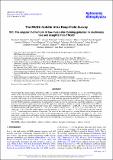The MUSE Hubble Ultra Deep Field Survey: XVI. The angular momentum of low-mass star-forming galaxies: A cautionary tale and insights from TNG50
Author(s)
Bouché, Nicolas F; Genel, Shy; Pellissier, Alisson; Dubois, Cédric; Contini, Thierry; Epinat, Benoît; Pillepich, Annalisa; Krajnović, Davor; Nelson, Dylan; Abril-Melgarejo, Valentina; Richard, Johan; Boogaard, Leindert; Maseda, Michael; Mercier, Wilfried; Bacon, Roland; Steinmetz, Matthias; Vogelsberger, Mark; ... Show more Show less
DownloadPublished version (2.816Mb)
Publisher with Creative Commons License
Publisher with Creative Commons License
Creative Commons Attribution
Terms of use
Metadata
Show full item recordAbstract
We investigate the specific angular momentum (sAM) j(<r) profiles of intermediate redshift (0.4 < z < 1.4) star-forming galaxies
(SFGs) in the relatively unexplored regime of low masses (down to M? ∼ 108 M ) and small sizes (down to Re ∼ 1.5 kpc), and
we characterize the sAM scaling relation (i.e., Fall relation) and its redshift evolution. We have developed a 3D methodology to
constrain sAM profiles of the star-forming gas using a forward modeling approach with GalPaK3D that incorporates the effects of
beam smearing, yielding the intrinsic morpho-kinematic properties even with limited spatial resolution data. Using mock observations
from the TNG50 simulation, we find that our 3D methodology robustly recovers the star formation rate (SFR)-weighted ̃j?(<r) profiles
down to a low effective signal-to-noise ratio of '3. We applied our methodology blindly to a sample of 494 [O ii]-selected SFGs in
the MUSE Ultra Deep Field (UDF) 9 arcmin2 mosaic data, covering the unexplored 8 < logM?/M < 9 mass range. We find that
the (SFR-weighted) sAM relation follows ̃j? ∝ Mα
? with an index α varying from α = 0.3 to α = 0.5, from logM?/M = 8 to
logM?/M = 10.5. The UDF sample supports a redshift evolution ̃j? ∝ (1 + z)a, with a = −0.27+0.42
−0.56 which is consistent with the
(1 + z)−0.5 expectation from a universe in expansion. The scatter of the sAM sequence is a strong function of the dynamical state
with log j|M? ∝ 0.65+0.06
−0.08 × log(Vmax/σ), where σ is the velocity dispersion at 2Re. In TNG50, SFGs also form a ̃j? − M? − (V/σ)
plane, but it correlates more with galaxy size than with morphological parameters. Our results suggest that SFGs might experience a
dynamical transformation, and lose their sAM, before their morphological transformation to becoming passive via either merging or
secular evolution.
Date issued
2021Department
Massachusetts Institute of Technology. Department of PhysicsJournal
Astronomy and Astrophysics
Publisher
EDP Sciences
Citation
Bouché, Nicolas F, Genel, Shy, Pellissier, Alisson, Dubois, Cédric, Contini, Thierry et al. 2021. "The MUSE Hubble Ultra Deep Field Survey: XVI. The angular momentum of low-mass star-forming galaxies: A cautionary tale and insights from TNG50." Astronomy and Astrophysics, 654.
Version: Final published version